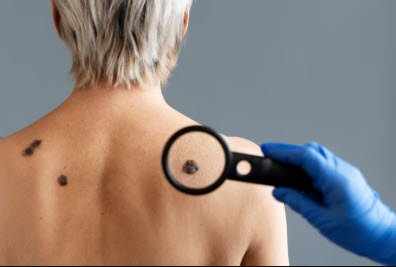Understanding Skin Cancer
Skin cancer develops when abnormal cells grow uncontrollably in the skin's layers. It's the most common cancer in the United States, with over 5 million cases diagnosed annually. Most skin cancers are caused by ultraviolet (UV) radiation exposure from sunlight or tanning beds.
Among the main types, basal cell carcinoma (BCC) is the most common form of skin cancer. It typically develops on sun-exposed areas such as the face, ears, neck, and arms. BCC tends to grow slowly and rarely metastasizes, but if left untreated, it can cause significant tissue damage.
Squamous cell carcinoma (SCC), another common type, usually appears on areas with frequent sun exposure as well, and may present as a firm, red nodule or a scaly, ulcerated lesion. While both BCC and SCC are considered non-melanoma skin cancers, they require prompt medical attention to prevent further complications. Early detection and treatment are crucial for all skin cancer types, emphasizing the importance of awareness and regular skin checks.
Main Types of Skin Cancer
1. Basal Cell Carcinoma (BCC)
- Most common type (about 80% of cases)
- Slow-growing, rarely spreads
- Appears as pearly bumps, pink patches, or sores that don't heal
- Most often on sun-exposed areas (face, ears, neck)
2. Squamous Cell Carcinoma (SCC)
- Second most common type
- Can grow deeper and spread if untreated
- Appears as red firm bumps, scaly patches, or wart-like growths
- Common on sun-exposed areas and lips
3. Melanoma
- Less common but more dangerous
- Can spread quickly if not caught early
- Follows the ABCDE rule for identification
- Can develop anywhere on the body
Warning Signs (ABCDE Rule for Melanoma)
- Asymmetry: One half doesn't match the other
- Border: Irregular, scalloped, or poorly defined edges
- Color: Varied shades of brown, black, red, white, or blue
- Diameter: Larger than 6mm (pencil eraser size)
- Evolving: Changing in size, shape, or color
Risk Factors
- UV exposure (sunlight/tanning beds)
- Fair skin, light hair/eye color
- History of sunburns
- Many moles or atypical moles
- Family history of skin cancer
- Weakened immune system
Diagnosis Process
- Visual examination by dermatologist
- Dermoscopy (magnified skin inspection)
- Skin biopsy (shave, punch, or excisional)
- Imaging tests if metastasis is suspected
Treatment Options
Non-Melanoma Treatments
- Excision surgery
- Mohs surgery (for sensitive areas)
- Curettage and electrodesiccation
- Cryotherapy (freezing)
- Topical medications
- Photodynamic therapy
Melanoma Treatments
- Wide local excision
- Sentinel lymph node biopsy
- Immunotherapy
- Targeted therapy
- Chemotherapy (for advanced cases)
- Radiation therapy
Frequently Asked Questions
Q: Can you get skin cancer in areas not exposed to sun?
A: Yes, though less common. Melanoma can occur on palms, soles, under nails, and genitals. Regular full-body checks are important.
Q: How often should I check my skin?
A: Monthly self-exams and annual professional skin checks are recommended. High-risk individuals may need more frequent exams.
Q: Does sunscreen really prevent skin cancer?
A: Yes, regular use of broad-spectrum SPF 30+ sunscreen reduces melanoma risk by 50% and SCC risk by 40%. Reapplication every 2 hours is key.
Q: Are tanning beds safer than sun exposure?
A: No, tanning beds emit concentrated UV radiation and increase melanoma risk by 75% when used before age 35.
Q: Can dark-skinned people get skin cancer?
A: Yes, though less common. When it occurs, it's often diagnosed at later stages. Everyone needs sun protection.
Prevention Strategies
- Use broad-spectrum SPF 30+ sunscreen daily
- Seek shade 10AM-4PM when UV is strongest
- Wear protective clothing and wide-brimmed hats
- Avoid tanning beds
- Check skin monthly for changes
- Get annual skin exams by a dermatologist
Key Takeaways
- Regular skin checks can detect cancer early when most treatable
- Know the ABCDE warning signs of melanoma
- Sun protection is crucial year-round
- Different types require different treatments
- Everyone is at risk regardless of skin color
The content of this post is provided for informational purposes only. It is essential to consult with a qualified healthcare professional before making any decisions regarding your health or wellness. The author is not a licensed medical professional, and this information should not be considered medical advice.
Tags: skin cancer, melanoma, basal cell carcinoma, squamous cell carcinoma, sun protection, ABCDE rule, cancer prevention, dermatology
Have you or someone you know experienced skin cancer? Share your detection or prevention tips in the comments below.
If you require any assistance with this article, please do not hesitate to Contact Us















